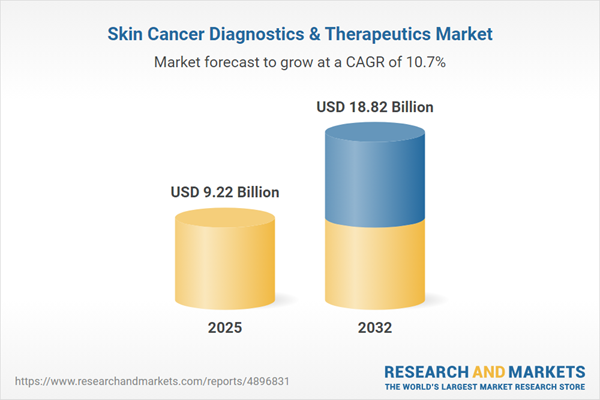Speak directly to the analyst to clarify any post sales queries you may have.
Senior executives operating in the skin cancer diagnostics and therapeutics market must navigate constant regulatory change, technological advancements, and shifting clinical standards to achieve successful outcomes in an evolving global environment.
Market Snapshot: Skin Cancer Diagnostics and Therapeutics Market Size and Growth
The global skin cancer diagnostics and therapeutics market demonstrates strong forward momentum, with a current valuation of USD 8.31 billion in 2024 and projected to reach USD 9.22 billion by 2025. This reflects a compound annual growth rate (CAGR) of 10.74%. By 2032, the sector is anticipated to achieve USD 18.82 billion. This solid growth is shaped by increasing prevalence of skin cancer, steady investments in molecular diagnostics, and advances in immuno-oncology. The accelerating pace of technology adoption and ongoing clinical innovation also set new benchmarks for market progression. As executives evaluate expansion strategies, aligning operational models with evolving industry priorities and adjusting to complicated regulatory environments remains fundamental to maintaining market leadership.
Scope & Segmentation: Strategic Insights for Executives
This report delivers key intelligence across crucial segments, enabling informed decisions that support competitive differentiation and resource optimization:
- Therapeutic Approaches: Evaluate both established and emerging methods including cryotherapy, cancer vaccines, immune checkpoint inhibitors, cytokine therapies, photodynamic treatment, and targeted agents like BRAF and MEK inhibitors. These insights support alignment of R&D investments with clinical efficacy and cost containment goals.
- Cancer Types: Assess specific requirements and clinical pathways for melanoma, basal cell carcinoma, and squamous cell carcinoma. Understanding these distinctions helps executives prioritize patient-centric workflows and deploy resources according to disease complexity.
- Diagnostic Modalities: Explore advancements such as confocal microscopy, dermoscopy, molecular profiling, and advanced imaging technologies including CT, MRI, ultrasound, and biopsy. These technologies enhance diagnostic accuracy and reduce time to treatment, supporting operational efficiency.
- End User Settings: Examine market dynamics in ambulatory surgery centers, dermatology clinics, hospitals, specialized cancer groups, and the emerging domain of home-based care. These environments influence capacity planning, resource allocation, and the design of patient engagement strategies.
- Geographical Regions: Benchmark trends and regulatory factors in the Americas, Europe, Middle East and Africa, and Asia Pacific. Regional insights support effective adaption of go-to-market approaches and the evaluation of local regulatory considerations.
- Key Companies: Gain comparative intelligence on industry leaders, including F. Hoffmann-La Roche, Thermo Fisher Scientific, Illumina, Siemens Healthineers AG, Abbott Laboratories, Merck & Co., Bristol-Myers Squibb, Novartis, Amgen, and Qiagen N.V. Profiles support competitive benchmarking and identification of partnership opportunities.
Key Takeaways for Senior Decision-Makers
- Collaboration across pharmaceutical, biotechnology, and medical device sectors is reshaping operational structures and enhancing market responsiveness.
- Digital pathology, artificial intelligence, and teledermatology are facilitating access to advanced diagnostics and enabling broader scalability in both established and emerging healthcare markets.
- Staying current with continually evolving regulatory and reimbursement guidelines is essential for effective and timely market entry.
- Workforce training and adherence to updated clinical best practices enable swift adoption of novel diagnostic and therapeutic tools.
- Embracing value-based care models contributes to improved patient outcomes and operational gains, establishing a clear organizational advantage.
- International research collaboration and regulatory harmonization bolster resilience and foster innovation across borders.
Tariff Impact on the Value Chain
Recent tariffs on U.S. medical devices and reagents have led stakeholders to diversify supply chain operations, renegotiate key supplier contracts, and consider nearshoring initiatives. These adjustments are tightly linked to reimbursement policy refinements and necessary updates to logistics networks. Proactive management of these dynamics strengthens business continuity and supports sustainable operations amid regulatory uncertainty.
Methodology & Data Sources
The findings are based on insights from direct interviews with senior clinical, procurement, and financial decision-makers, complemented by structured analysis of peer-reviewed literature and current regulatory frameworks. Scenario modeling informs the assessment of technology implementation and operational effectiveness throughout the skin cancer diagnostics and therapeutics sector.
Why This Report Matters
- Enables executive teams to anticipate market developments, regulatory shifts, and advances in clinical practice for strategic planning.
- Supplies actionable, segment-focused intelligence and robust benchmarking for confident decision-making and resource optimization.
- Provides practical recommendations to streamline operations and reinforce supply chain strategies in dynamic market conditions.
Conclusion
This report supports executive leadership with incisive analysis and targeted guidance, enabling informed strategy development and sustainable advancement in the complex skin cancer diagnostics and therapeutics market.
Additional Product Information:
- Purchase of this report includes 1 year online access with quarterly updates.
- This report can be updated on request. Please contact our Customer Experience team using the Ask a Question widget on our website.
Table of Contents
3. Executive Summary
4. Market Overview
7. Cumulative Impact of Artificial Intelligence 2025
Companies Mentioned
The companies profiled in this Skin Cancer Diagnostics & Therapeutics market report include:- F. Hoffmann-La Roche Ltd
- Thermo Fisher Scientific Inc.
- Illumina, Inc.
- Siemens Healthineers AG
- Abbott Laboratories
- Merck & Co., Inc.
- Bristol-Myers Squibb Company
- Novartis AG
- Amgen Inc.
- Qiagen N.V.
Table Information
| Report Attribute | Details |
|---|---|
| No. of Pages | 193 |
| Published | November 2025 |
| Forecast Period | 2025 - 2032 |
| Estimated Market Value ( USD | $ 9.22 Billion |
| Forecasted Market Value ( USD | $ 18.82 Billion |
| Compound Annual Growth Rate | 10.7% |
| Regions Covered | Global |
| No. of Companies Mentioned | 11 |









